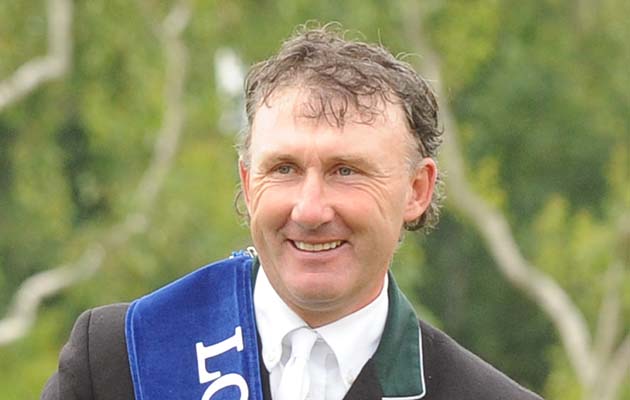Nick Skelton’s recent H&H column has prompted discussion across the country. H&H’s showjumping editor Jennifer Donald seeks reaction from a cross-section of individuals including: Sarah Lewis – young horse producer and trainer of amateur riders; Matt Hoskins – course-designer, show organiser, business owner and former rider; Adam Cromarty – broadcaster, commentator, judge and husband to an amateur showjumper; and Jay Halim – rider, producer and breeder
Never has a comment in H&H sparked such an impassioned response or inspired such feverish debate as Nick Skelton’s opinion piece
Whether people were nodding sagely in agreement with his proposals for British showjumping or wished to tear up their copy of the magazine in disgust, as showjumper Jay Halim shrewdly observes, “How lucky are we to have so many people who care so passionately about our sport?”
It’s impossible to please everyone in such a diverse sport where both leisure riders and Olympic medallists need to be catered for, so it’s no surprise that so many are calling out for change. To reflect just some of the many opinions, we spoke to a cross-section of people involved in the industry to hear their views about what’s working for them and what isn’t, and where the sport might go from here.
Do let us know your thoughts, too, at hhletters@ti-media.com
{"content":"PHA+PGVtPjxzdHJvbmc+U2FyYWggTGV3aXMsIHlvdW5nIGhvcnNlIHByb2R1Y2VyIGFuZCB0cmFpbmVyIG9mIGFtYXRldXIgcmlkZXJzLCBzYXlzJiM4MjMwOzwvc3Ryb25nPjwvZW0+PC9wPgo8cD48ZGl2IGNsYXNzPSJhZC1jb250YWluZXIgYWQtY29udGFpbmVyLS1tb2JpbGUiPjxkaXYgaWQ9InBvc3QtaW5saW5lLTIiIGNsYXNzPSJpcGMtYWR2ZXJ0Ij48L2Rpdj48L2Rpdj48c2VjdGlvbiBpZD0iZW1iZWRfY29kZS0zMSIgY2xhc3M9ImhpZGRlbi1tZCBoaWRkZW4tbGcgcy1jb250YWluZXIgc3RpY2t5LWFuY2hvciBoaWRlLXdpZGdldC10aXRsZSB3aWRnZXRfZW1iZWRfY29kZSBwcmVtaXVtX2lubGluZV8yIj48c2VjdGlvbiBjbGFzcz0icy1jb250YWluZXIgbGlzdGluZy0tc2luZ2xlIGxpc3RpbmctLXNpbmdsZS1zaGFyZXRocm91Z2ggaW1hZ2UtYXNwZWN0LWxhbmRzY2FwZSBkZWZhdWx0IHNoYXJldGhyb3VnaC1hZCBzaGFyZXRocm91Z2gtYWQtaGlkZGVuIj4NCiAgPGRpdiBjbGFzcz0icy1jb250YWluZXJfX2lubmVyIj4NCiAgICA8dWw+DQogICAgICA8bGkgaWQ9Im5hdGl2ZS1jb250ZW50LW1vYmlsZSIgY2xhc3M9Imxpc3RpbmctaXRlbSI+DQogICAgICA8L2xpPg0KICAgIDwvdWw+DQogIDwvZGl2Pg0KPC9zZWN0aW9uPjwvc2VjdGlvbj48L3A+CjxwPk5pY2sgbWVudGlvbmVkIHRoZSBudW1iZXIgb2YgcmlkZXJzIHRyYXZlbGxpbmcgdG8gRXVyb3BlYW4gc2hvd3MgYW5kIEkgYW0gb25lIG9mIHRoZW0uIEkgYnV5IGFuZCBwcm9kdWNlIHlvdW5nc3RlcnMgYW5kIEkgZmluZCB0aGV5IHByb2dyZXNzIGJlc3QgYnkgY29tcGV0aW5nIGF0IGludGVybmF0aW9uYWwgeW91bmcgaG9yc2Ugc2hvd3MuIFRoZSBudW1iZXIgb25lIHJlYXNvbiBpcyB0aGUgY291cnNlcy48L3A+CjxwPldlIHVzdWFsbHkgc3RhcnQgZml2ZS15ZWFyLW9sZHMgd2l0aCBhIGNsZWFyIHJvdW5kIG9uIHRoZSBkYXkgd2UgYXJyaXZlLiBUaGlzIGNvc3RzIOKCrDEwLiBPbiB0aGUgZmlyc3QgZGF5IG9mIGNvbXBldGl0aW9uLCB0aGUgY291cnNlIG1pZ2h0IGJlIDEuMDVtIHRocm91Z2hvdXQsIGJ1dCBzdHJhaWdodGZvcndhcmQgd2l0aCBubyB3YXRlciB0cmF5LjwvcD4KPHA+T24gZGF5IHR3bywgdGhlIHdhdGVyIHRyYXkgaXMgaW5jbHVkZWQgYXMgdGhlIGxhc3QgZmVuY2UsIHRoZW4gb24gdGhlIGZpbmFsIGRheSB5b3UgaGF2ZSBhbiB1cC10by1oZWlnaHQgZ3JhbmQgcHJpeCwgd2l0aCBtYXliZSBhIGNvbWJpbmF0aW9uIGFuZCBhIHRyYXkuIEV2ZXJ5IGRheSBpcyBzbGlnaHRseSBiaWdnZXIgYW5kIG1vcmUgdGVjaG5pY2FsLCBzbyBob3JzZXMgbGVhcm4gYW5kIGltcHJvdmUgb3ZlciB0aGUgc2hvdy48L3A+CjxkaXYgY2xhc3M9ImFkLWNvbnRhaW5lciBhZC1jb250YWluZXItLW1vYmlsZSI+PGRpdiBpZD0icG9zdC1pbmxpbmUtMyIgY2xhc3M9ImlwYy1hZHZlcnQiPjwvZGl2PjwvZGl2Pgo8cD5UaGUgbWluZHNldCBhdCB0aGVzZSBzaG93cyBpcyB0aGF0IGV2ZXJ5b25lIHNob3VsZCBlbmpveSB0aGVtc2VsdmVzLCBnbyB3ZWxsIGFuZCB0aGF0IHRoZSBiZXN0IHJvdW5kIHdpbGwgd2luLiBJ4oCZdmUgbGVhcm5lZCBzbyBtdWNoIGJlY2F1c2UgZXZlcnlvbmUgaXMgc3VwcG9ydGl2ZS4gTm8geW91bmcgaG9yc2UgcHJvZHVjZXIgaXMgaW4gaXQgdG8gd2luIHByaXplIG1vbmV5IOKAkyBuZWl0aGVyIGluIEJyaXRhaW4gbm9yIEV1cm9wZS48L3A+CjxwPk5pY2vigJlzIGlkZWEgb2YgYnVyc2FyaWVzIHRvIGltcHJvdmUgQnJpdGlzaCBjZW50cmVzIGlzIGV4Y2VsbGVudC4gV2UgaGF2ZSBtYW55IGdvb2QgdmVudWVzIHRoYXQsIHdpdGggZXh0cmEgaW52ZXN0bWVudCBhbmQgaGVscCwgY291bGQgbWF0Y2ggRXVyb3BlYW4gdmVudWVzIGFuZCBlbmNvdXJhZ2UgbW9yZSByaWRlcnMgdG8gc3RheSBvbiBob21lIHNvaWwuPC9wPgo8ZGl2IGNsYXNzPSJhZC1jb250YWluZXIgYWQtY29udGFpbmVyLS1tb2JpbGUiPjxkaXYgaWQ9InBvc3QtaW5saW5lLTQiIGNsYXNzPSJpcGMtYWR2ZXJ0Ij48L2Rpdj48L2Rpdj4KPHA+SG93ZXZlciwgSSBkbyB3aXNoIHNob3dqdW1waW5nIGluIEJyaXRhaW4gd2FzIG1vcmUgY29oZXNpdmUuIE1heWJlIGFtYXRldXIgcmlkZXJzIGNvdWxkIGJlIGNhdGVnb3Jpc2VkIGJldHRlciwgc28gdGhhdCB3aGF0ZXZlciB0aGUgaGVpZ2h0IG9mIHRoZWlyIGNvbWZvcnQgem9uZSB0aGV5IGFyZSBjb21wZXRpbmcgYWdhaW5zdCB0aGVpciB0cnVlIHBlZXIgZ3JvdXAuPC9wPgo8cD5UaGVyZSBpcyBzbyBtdWNoIGluIG91ciBzcG9ydCB0byBiZSBwcm91ZCBvZiwgbm90IGxlYXN0IGJlY2F1c2Ugb3VyIHJpZGVycyBoYXZlIHdvbiBnb2xkIG1lZGFscyBhdCB0aGUgcGFzdCB0d28gT2x5bXBpY3MuIFdlIGp1c3QgbmVlZCB0byBwdWxsIHRvZ2V0aGVyLjwvcD4KPGRpdiBjbGFzcz0iYWQtY29udGFpbmVyIGFkLWNvbnRhaW5lci0tbW9iaWxlIj48ZGl2IGlkPSJwb3N0LWlubGluZS01IiBjbGFzcz0iaXBjLWFkdmVydCI+PC9kaXY+PC9kaXY+CjxwPjxlbT48c3Ryb25nPk1hdHQgSG9za2lucywgY291cnNlLWRlc2lnbmVyLCBzaG93IG9yZ2FuaXNlciwgYnVzaW5lc3Mgb3duZXIgYW5kIGZvcm1lciByaWRlciwgc2F5cyYjODIzMDs8L3N0cm9uZz48L2VtPjwvcD4KPHA+T3VyIGJpZ2dlc3QgY2hhbGxlbmdlIGlzIHRvIGdldCBtb3JlIGV4cG9zdXJlIGZvciBvdXIgc3BvcnQgYnkgbWFraW5nIG91ciByaWRlcnMsIHdobyBhcmUgYW1vbmcgdGhlIGJlc3QgaW4gdGhlIHdvcmxkLCBob3VzZWhvbGQgbmFtZXMgYWdhaW4uPC9wPgo8cD5UaGUgQkJDIGFuZCBJVFYgYXJlIHN0cnVnZ2xpbmcgdG8gZmluZCBzcG9ydHMgdGhleSBjYW4gYWZmb3JkIHRvIGNvdmVyLCBzbyB3aHkgbm90IHRha2UgYSBwcm9wb3NhbCB0byB0aGVtIHRvIGNvdmVyIDE2IHJpZGVycyBkb2luZyBhIGRpZmZlcmVudCB0eXBlIG9mIGNvbXBldGl0aW9uIGVhY2ggd2Vlaz8gQXQgdGhlIG1vbWVudCwgdmlld2VycyBjYW4gZmluZCBuZXRiYWxsIG9uIHRoZSByZWQgYnV0dG9uLiBXaHkgaXNu4oCZdCBzaG93anVtcGluZyB0aGVyZT88L3A+CjxwPlRoZSBzcG9ydCBpbiBCcml0YWluIHNlZW1zIHRvIGhhdmUgZm91ciBzZWN0b3JzOiBhbWF0ZXVycywgcHJvZmVzc2lvbmFsIChoaWdoZXIgbGV2ZWwpYW1hdGV1cnMsIHByb2R1Y2VycyBhbmQgdGhlIHRvcCBsZXZlbC4gVG8gaGVscCBldmVyeW9uZSwgd2UgbmVlZCBjb25zaXN0ZW5jeSBhY3Jvc3MgdGhlIHNwb3J0LCBlc3BlY2lhbGx5IHdoZW4gaXQgY29tZXMgdG8gY291cnNlcy4gQXQgdGhlIG1vbWVudCwgYSBuZXdjb21lcnMgdHJhY2ssIGZvciBpbnN0YW5jZSwgY291bGQgYmUgYXQgYSBkaWZmZXJlbnQgaGVpZ2h0IGFuZCBsZXZlbCBvZiBkaWZmaWN1bHR5IGF0IHRocmVlIGRpZmZlcmVudCB2ZW51ZXMuIFRoYXTigJlzIG5vdCBhbHdheXMgdGhlIGNvdXJzZS1idWlsZGVy4oCZcyBmYXVsdCwgYnV0IHBlcmhhcHMgdGhlcmUgaXMgdG9vIG11Y2ggbGVld2F5IGluIHRoZSBydWxlYm9vay48L3A+CjxwPkZvcmVpZ24gdmlzaXRvcnMgY2Fubm90IGJlbGlldmUgdGhhdCBhIDEuMTBtIG5ld2NvbWVycyBjbGFzcyBpc27igJl0IDEuMTBtIGZyb20gc3RhcnQgdG8gZmluaXNoLiBXaXRoIHNpbmdsZS1waGFzZSwgaXQgbWlnaHQgYmUgMW0gdG8gc3RhcnQgd2l0aCwgdGhlbiAxLjEwbSwgd2l0aCB0aGUgc2Vjb25kIGhhbGYgYXQgMS4yMG0uIE1heWJlIHdlIHNob3VsZCBhZG9wdCB0aGUgRkVJIHN0YW5kYXJkIG9mIGEgY2xhc3MgYmVpbmcgdGhlIGhlaWdodCBpdCBzYXlzIGl0IGlzLCB3aXRoIG5vIHRlY2huaWNhbCB0cmlja3MgZm9yIHlvdW5nIGhvcnNlcy48L3A+CjxwPkkgdXNlZCB0byBjb21wZXRlIHVwIHRvIDEuMzBtIHdoZW4gQTcgd2FzIHRoZSBub3JtLCBidXQgSSB3b3VsZG7igJl0IHdhbnQgdG8gZG8gdGhhdCB0aGVzZSBkYXlzIGJlY2F1c2UgdGhlIHNlY29uZCBoYWxmIG9mIGEgMS4zMG0gc2luZ2xlLXBoYXNlIGlzIG9mdGVuIDEuNDBtLiBUaGF04oCZcyBkaWZmaWN1bHQgZm9yIHRoZSBwcm9mZXNzaW9uYWwgYW1hdGV1ci48L3A+CjxwPkkgYWdyZWUgbmV3Y29tZXJzIGFuZCBGb3hodW50ZXJzIHNob3VsZCBiZWNvbWUgYWdlIGNsYXNzZXMuIEJ1dCB0byBkbyBzbywgdGhlIGNvdXJzZSBzcGVjaWZpY2F0aW9ucyBtdXN0IGJlIGxvb2tlZCBhdC4gQXQgdGhlIG1vbWVudCwgYm90aCBzZWNvbmQgcm91bmRzIGFyZSBBOCBjbGFzc2VzICh0aHJlZS1yb3VuZGVycykgYW5kIHN0YXJ0IGF0IDEuMjVtIGZvciBuZXdjb21lcnMgYW5kIDEuMzBtIGZvciB0aGUgRm94aHVudGVyLiBXb3VsZCB3ZSBiZSBhc2tpbmcgeW91bmcgaG9yc2VzIHRvbyBtYW55IHF1ZXN0aW9ucyBieSByb3VuZCB0aHJlZT88L3A+CjxwPjxlbT48c3Ryb25nPkFkYW0gQ3JvbWFydHksIGJyb2FkY2FzdGVyLCBjb21tZW50YXRvciwganVkZ2UgYW5kIGh1c2JhbmQgdG8gYW4gYW1hdGV1ciBzaG93anVtcGVyLCBzYXlzJiM4MjMwOzwvc3Ryb25nPjwvZW0+PC9wPgo8cD5NeSBvd24gb3BpbmlvbnMgZG8gbm90IGNvbXBsZXRlbHkgYWxpZ24gd2l0aCB0aG9zZSBvZiBOaWNrLCBob3dldmVyIGhlIGlzIGEgd29ybGQtY2xhc3MgYXRobGV0ZSB3aG8gaGFzIGRlZGljYXRlZCBoaXMgbGlmZSB0byBlcXVlc3RyaWFuIHNwb3J0IGFuZCBJIGFwcGxhdWQgaGltIGZvciB3YW50aW5nIHRvIHVzZSBoaXMgZXhwZXJpZW5jZSB0byBiZXR0ZXIgc2hvd2p1bXBpbmcgaW4gdGhlIFVLLjwvcD4KPHA+SSB3b3JrIGF0IHNob3dzIGFyb3VuZCB0aGUgd29ybGQsIGFuZCB0aGlzIGV4cG9zdXJlIGdpdmVzIGEgZmFzY2luYXRpbmcgaW5zaWdodCBpbnRvIGhvdyB0aGUgc3BvcnQgaXMgbWFuYWdlZCBpbiBkaWZmZXJlbnQgdGVycml0b3JpZXMuIEl0IHNlZW1zIHRoZXJlIG5lZWRzIHRvIGJlIGEgcmV2aWV3IG9mIHRoZSByZXF1aXJlbWVudHMgbmVlZGVkIHRvIGhvc3QgYWZmaWxpYXRlZCBldmVudHMgaW4gdGhlIFVLLjwvcD4KPHA+V2hlbiBnb2luZyB0byBzaG93cyBhcyBhIGh1c2JhbmQgKGdyb29tKSwgSSBhcHByZWNpYXRlIHZlbnVlcyB3aXRoIGV4Y2VwdGlvbmFsIGhvcnNlIGZhY2lsaXRpZXMsIGJ1dCBhbHNvIHdoZXJlIGh1bWFuIGFtZW5pdGllcyBoYXZlIGJlZW4gZ2l2ZW4gc29tZSBjb25zaWRlcmF0aW9uLiBJdCBtYXkgYWxzbyBiZSBlYXNpZXIgdG8gYXR0cmFjdCBzcG9uc29ycyBpZiB0aGV5IGNvdWxkIGJyaW5nIGNsaWVudHMgZm9yIGRpbm5lciBhbmQgZmVlbCBsaWtlIHRoZXkgYXJlIGluIGEgcGxlYXNpbmcgZW52aXJvbm1lbnQgd2hpbGUgd2F0Y2hpbmcgb3VyIHNwb3J0LjwvcD4KPHA+U2hvd2p1bXBpbmcgaGFzIG1vdmVkIGZyb20gaGF2aW5nIG11bHRpLWRheSBldmVudHMgd2l0aCBldmVuaW5nIGVudGVydGFpbm1lbnQgdG8gYW4gYWJ1bmRhbmNlIG9mIHNpbmdsZS1kYXkgc2hvd3Mgd2hlcmUgd2UganVtcCBldmVyeXRoaW5nIGFzIGZhc3QgYXMgcG9zc2libGUsIHVzaW5nIHNpbmdsZS1waGFzZSBydWxlcy4gVG8gbWUsIHRoaXMgaXNu4oCZdCBzcG9ydDsgaXTigJlzIGEgZmFjdG9yeSB0aGF0IGFsbG93cyBmb3IgcGVvcGxlIHRvIHByb2R1Y2UgaG9yc2VzIHNvIHRoZXkgY2FuIHNlbGwgdGhlbS48L3A+CjxwPknigJltIG5vdCBpZGVhbGlzdGljIGFuZCBJIGNhbiBzZWUgdGhlIHZpZXdwb2ludCBvZiB0aG9zZSB3aG8gdXNlIHRoZSBpbmR1c3RyeSB0byBmdW5kIHRoZWlyIGJ1c2luZXNzLiBIb3dldmVyLCBpZiB3ZSB3YW50IHRvIHByb21vdGUgdGhlIHNwb3J0LCBJIHdvdWxkIHN1Z2dlc3QgY3V0dGluZyBkb3duIHRoZSBudW1iZXIgb2Ygc2hvd3MgYW5kIGFzayBldmVudCBvcmdhbmlzZXJzIHRvIHRlbmRlciBmb3Igd2Vla2VuZCBkYXRlcy4gV2hhdCBhcmUgdGhleSBvZmZlcmluZyB0aGF0IGlzIGV4Y2VwdGlvbmFsPyBEbyB0aGV5IGhhdmUgc3BvbnNvcnM\/IEFyZSB0aGV5IHVzaW5nIGEgY29tbWVudGF0b3I\/IFRoZW4gd2Vla2RheSBzaG93cyBjYW4gYmUgZ2VhcmVkIHRvd2FyZHMgdGhlIGV4cHJlc3MgbWV0aG9kLjwvcD4KPHA+SW5zdGVhZCBvZiByYWlzaW5nIHRoZSBjb3N0IG9mIG1lbWJlcnNoaXAsIHdlIHNob3VsZCBsb29rIGF0IGluY3JlYXNpbmcgZW50cnkgZmVlcyBhbmQgY3JlYXRpbmcgYW4gZW52aXJvbm1lbnQgd2hlcmUgdGhlIG51bWJlcnMgaW4gZWFjaCBjb21wZXRpdGlvbiBtYWtlIHJ1bm5pbmcgc2hvd3MgYSB2aWFibGUgYnVzaW5lc3MuIFRoaXMgY291bGQgbGVhZCB0byBmYWNpbGl0eSBpbnZlc3RtZW50IGFuZCBiZWluZyBhYmxlIHRvIHBheSBzaG93IG9mZmljaWFscyBhIGZlZSB0aGF0IGtlZXBzIHRoZSBiZXN0IGV4cGVydGlzZSBpbiB0aGUgVUsuPC9wPgo8cD5UaGUgeW91bmcgaG9yc2UgZXZlbnRzIHRoYXQgaGF2ZSBiZWVuIGFkZGVkIHRvIHRoZSBjYWxlbmRhciBhcmUgYSBwb3NpdGl2ZSBzdGVwLCBidXQgcHJvZHVjZXJzIGFyZSBvbmx5IGEgcHJvcG9ydGlvbiBvZiB0aGUgb3ZlcmFsbCBtZW1iZXJzaGlwLjwvcD4KPHA+QWdlIGNsYXNzZXMgYXJlIGFscmVhZHkgcnVuIGFsb25nc2lkZSB0aGUgZXhpc3RpbmcgbmF0aW9uYWwgc2VyaWVzIGJ1dCBwZXJoYXBzIHRoZXkgY291bGQgb2ZmZXIgZHVhbCBxdWFsaWZpY2F0aW9uIGZvciBhZ2Utc3BlY2lmaWMgZmluYWxzLjwvcD4KPHA+VGhlIHRlcm0gYW1hdGV1ciBhbHdheXMgc2VlbXMgdG8gY2F1c2UgYSByZWFjdGlvbiwgYXMgaWYgaXQgaXMgYSBkZXJvZ2F0b3J5IHRlcm0uIEkgdGhpbmsgdGhlIG9wcG9zaXRlIGlzIHRydWUuIEluIE5vcnRoIEFtZXJpY2EsIHRoZXkgcnVuIHlvdW5nIHJpZGVyIGFuZCBhbWF0ZXVyIGNsYXNzZXMgdXAgdG8gMS40MG0sIGFuZCBhbWF0ZXVyIHJpZGVycyB3aG8gYXJlIGp1bXBpbmcgY29tcGV0aXRpb25zIHN1Y2ggYXMgV29ybGQgQ3VwcyB3YW50IHRvIG1haW50YWluIHRoZWlyIGFtYXRldXIgc3RhdHVzIHNvIHRoZXkgY2FuIGp1bXAgdGhlaXIgeW91bmcgaG9yc2VzIGFyb3VuZCBsZXNzIHRlY2huaWNhbCBjb3Vyc2VzLjwvcD4KPHA+SSB0aGluayB0aGV5IGRvIGhhdmUgYSBwbGFjZSBhdCBIb3JzZSBvZiB0aGUgWWVhciBTaG93LiBXZSBuZWVkIHRvIGdpdmUgdGhlIGxhcmdlc3QgZ3JvdXAgb2YgY29tcGV0aXRvcnMgc29tZXRoaW5nIHRvIGFpbSB0b3dhcmQuPC9wPgo8cD5Db25zdHJ1Y3RpdmUgZGlzY3Vzc2lvbiBiZXR3ZWVuIHRoZSBjb3JyZWN0IHBhcnRpZXMgaXMgc28gdmFsdWFibGUgYW5kIEkgYW0gc3VyZSBvdXIgbmF0aW9uYWwgZ292ZXJuaW5nIGJvZHkgd2lsbCBjb250aW51ZSB0byBleHBsb3JlIGFsbCBwcm9wb3NhbHMsIGJ1dCB3ZSBhbHNvIG5lZWQgdG8gYWNjZXB0IHRoYXQgaXTigJlzIE9LIHRvIGhhdmUgZGlmZmVyZW50IHZpZXdwb2ludHMuPC9wPgo8cD48ZW0+PHN0cm9uZz5KYXkgSGFsaW0sIHJpZGVyLCBwcm9kdWNlciBhbmQgYnJlZWRlciwgc2F5cyYjODIzMDs8L3N0cm9uZz48L2VtPjwvcD4KPHA+V2h5IGlzIG1vcmUgbm90IGJlaW5nIGRvbmUgdG8gaGVscCBvdXIgc2hvdyBjZW50cmVzPyBOaWNr4oCZcyBwb2ludCBhYm91dCBwdXR0aW5nIG1vbmV5IGJhY2sgaW4gdG8gdGhlbSBpcyByZWFsbHkgdmFsaWQuPC9wPgo8cD5UaGUgcmVhc29uIG91ciB3aW50ZXIgY2lyY3VpdCBpcyBzbyBsaW1pdGVkIGlzIGJlY2F1c2Ugb2Ygc29tZW9uZeKAmXMgYXBhdGh5IGluIGdldHRpbmcgdGhlIGNyaXBwbGluZyBidXNpbmVzcyByYXRlcyBvdXIgc2hvdyBjZW50cmVzIGhhdmUgdG8gcGF5IHJlbW92ZWQuIFRoZSBhc3NvY2lhdGlvbnMgYW5kIEJyaXRpc2ggRXF1ZXN0cmlhbiBzaG91bGQgYmUgbG9iYnlpbmcgcGFybGlhbWVudCBhbmQgZG9pbmcgbW9yZSB0byBzdXBwb3J0IHRoZW0uPC9wPgo8cD5JbiBteSBtaW5kLCB0aGVyZSByZWFsbHkgYXJlIG9ubHkgdGhyZWUgaW5kb29yIHZlbnVlcyBpbiB0aGlzIGNvdW50cnkgdGhhdCBhcmUgZml0IGZvciBwdXJwb3NlIHRvIGNvcGUgd2l0aCB3aW50ZXIgc3BvcnQuPC9wPgo8cD5BIG1ham9yIGNoYW5nZSBJ4oCZZCBsaWtlIHRvIHNlZSwgc3RhcnRpbmcgYXQgbWlkLXdlZWsgc2hvd3Mg4oCTIHByZWRvbWluYW50bHkgYXR0ZW5kZWQgYnkgcHJvZmVzc2lvbmFsIHJpZGVycyDigJMgaXMgYSBmaXZlLWNsYXNzIHNjaGVkdWxlIHN0YXJ0aW5nIHdpdGggYSAxbSBjbGFzcywgZm9sbG93ZWQgYnkgMS4xMG0sIDEuMjBtLCAxLjMwbSBhbmQgZW5kaW5nIHdpdGggdGhlIDEuNDBtLjwvcD4KPHA+TW9zdCBpbXBvcnRhbnRseSwgdGhlIGNvdXJzZSBzaG91bGQgcmVtYWluIHRoZSBzYW1lIGZvciBldmVyeSBjbGFzcyDigJMgaXQgc2hvdWxkIGNvbnRhaW4gZ3JvdW5kIGxpbmVzIHVwIHRvIHRoZSAxLjIwbSBjbGFzcywgYSBMaXZlcnBvb2wgYXQgdGhlIGVuZCwgYW5kIGEgY29tYmluYXRpb24uIE15IHRoZW9yeSBiZWhpbmQgdGhpcyBpcyB0aGF0LCB3aGV0aGVyIHlvdeKAmXJlIG9uIGEgeW91bmcgaG9yc2Ugb3IgeW914oCZcmUgbGVzcyBleHBlcmllbmNlZCwgaWYgeW91IGdldCBhIGxpbmUgd3JvbmcgeW91IGNhbiBnbyBiYWNrIGluIHRoZSBuZXh0IGNsYXNzIGFuZCB0cnkgYWdhaW4g4oCTIGl04oCZcyBvbmx5IHR3byBob2xlcyBoaWdoZXIuPC9wPgo8cD5UcmFpbmluZyBhbmQgcHJvZ3Jlc3Npb24gaXMgYWxsIGFib3V0IHJlcGV0aXRpb24gYW5kIGNvbnRpbnVpdHksIGFuZCBpZiB5b3Ugd2VyZSByaWRpbmcgYXQgaG9tZSB5b3XigJlkIHJlcGVhdCB0aGUgc2FtZSBsaW5lIHNldmVyYWwgdGltZXMuIFRoZSBzYW1lIHByaW5jaXBhbHMgYXBwbHkgaGVyZSwgYW5kIEnigJltIHN1cmUgQnJpdGlzaCBTaG93anVtcGluZyB3b3VsZCBzZWUgYW4gaW5jcmVhc2UgaW4gZW50cmllcyBhcyBwZW9wbGUgd291bGQgYmUgbW9yZSBpbmNsaW5lZCB0byBqdW1wIG1vcmUgdGhhbiBvbmUgY2xhc3MsIHdhbnRpbmcgdG8gcHJvZ3Jlc3MuPC9wPgo8cD5UaGlzIGNvbnRpbnVpdHkgb2YgY291cnNlcyB3b3VsZCBjYXRlciBmb3IgYm90aCBwcm9mZXNzaW9uYWxzIGFuZCBhbWF0ZXVycyBzbyBpdOKAmXMgd2luLXdpbi4gTWFueSBwZW9wbGUgc2VlIGR1cGxpY2F0aW9uIG9mIGNvdXJzZXMgYXMgbGF6aW5lc3Mgb24gYmVoYWxmIG9mIHRoZSBjb3Vyc2UtZGVzaWduZXIgYnV0IGl04oCZcyBwcmVmZXJhYmxlIHRvIGNoYW5nZSBmb3IgdGhlIHNha2Ugb2YgaXQg4oCTIGZhciBiZXR0ZXIgdGhleSBidWlsZCBvbmUgZXhjZWxsZW50IGNvdXJzZSBhbmQgc3RpY2sgd2l0aCBpdC48L3A+CjxwPlNob3dzIHNob3VsZCBhbHNvIGJlIGFibGUgdG8gYWx0ZXIgdGhlIHNjaGVkdWxlIGFjY29yZGluZyB0byBzdXBwbHkgYW5kIGRlbWFuZCDigJMgZXZlcnkgc2hvdyBjZW50cmUgc2hvdWxkIGtub3cgdGhlaXIgY2xpZW50w6hsZSwgc28gaWYgeW914oCZcmUgaW4gYW4gYXJlYSB3aXRoIGEgc3Ryb25nZXIgYmFzZSBvZiBwcm9mZXNzaW9uYWwgcmlkZXJzIHlvdSBjb3VsZCBzdGFydCBhdCAxLjEwbSBhbmQgZmluaXNoIHdpdGggYSAxLjUwbSBjbGFzcyBpbnN0ZWFkLiBUaGV5IHNob3VsZG7igJl0IGJlIGFmcmFpZCB0byBicmVhayB0aGUgbW91bGQuPC9wPgo8cD5JZiB5b3UgZmVlbCB0aGUgbmVlZCB0byBjYWxsIGl0IGEgbmV3Y29tZXJzIG9yIGEgRm94aHVudGVyIHRvIGdldCBkb3VibGUgY2xlYXJzIGZvciBhIGZpbmFsLCB0aGVuIHRoYXTigJlzIE9LIHRvby4gQnV0IE5pY2sgaGFkIHRoZSBnb29kIGlkZWEgdG8gZm9jdXMgb24geW91bmcgaG9yc2UgY2xhc3Nlcywgd2hpY2ggYXJlIHNwbGl0IHRvIGFjY29tbW9kYXRlIG9wZW4gaG9yc2VzLjwvcD4KPHA+RXZlbnR1YWxseSB0aGlzIHN5c3RlbSBjb3VsZCBiZSByb2xsZWQgb3V0IGF0IHRocmVlLWRheSBQcmVtaWVyIHNob3dzIHdoZXJlIHRoZSBmaXJzdCBkYXkgd291bGQgYmUgeW91ciDigJxkb3VibGUgY2xlYXIgZGF54oCdLCBidWlsZGluZyB0b3dhcmRzIHRoZSBncmFuZCBwcml4LCBhcyBpcyB0aGUgbm9ybSBvdmVyc2Vhcy48L3A+CjxkaXYgY2xhc3M9ImluamVjdGlvbiI+PC9kaXY+CjxwPk5pY2sgYnJvdWdodCB1cCBzbyBtYW55IGdvb2QgcG9pbnRzIGFuZCBtYXkgaGF2ZSBkaXZpZGVkIHRoZSBuYXRpb24gd2l0aCBzb21lIG9mIHRoZW0sIGJ1dCBob3cgbHVja3kgYXJlIHdlIHRoYXQgd2UgaGF2ZSBzbyBtYW55IHBlb3BsZSB3aG8gY2FyZSBzbyBwYXNzaW9uYXRlbHkgYWJvdXQgb3VyIHNwb3J0PyBOb3cgaXTigJlzIHRpbWUgZm9yIGNvdXJzZSBidWlsZGVycywgdmVudWUgb3duZXJzLCBwcm9kdWNlcnMgYW5kIHJpZGVycyB0byBoYXZlIHRoZWlyIG9waW5pb25zIHRha2VuIHNlcmlvdXNseSBhbmQgbW92ZSB0aGlzIGZvcndhcmQgaW4gYSBwb3NpdGl2ZSB3YXkuPC9wPgo8cD48ZW0+UmVmIEhvcnNlICZhbXA7IEhvdW5kOyAyOCBNYXkgMjAyMDwvZW0+PC9wPgo8cD4K"}
You may also be interested in…
Credit: Charles Sainsbury-Plaice
H&H’s showjumping columnist proposes how to give British showjumping a massive shake-up
H&H’s showjumping columnist reflects on the surge of support to improve the sport in Britain
Credit: Jon Stroud
H&H’s showjumping columnist on grabbing media attention – and why the time is right
Credit: Getty Images
H&H’s showjumping columnist reflects on a raft of new rules and encourages discussion
‘We want to make sure that when relaxations come in, we’re in a place to make use of them’
H&H showjumping editor
Jennifer is passionate at showjumping and her role as H&H’s showjumping editor has taken her around the world reporting from shows and interviewing riders, connections and those involved behind the scenes. Since joining H&H from BBC Sport in 2005, she has written on every subject across the equestrian sphere — from turnout rugs to stable management — and has interviewed gold medallists, world champions and winners galore. She also has first-hand experience of working in the equestrian industry as a riding instructor and yard manager.






